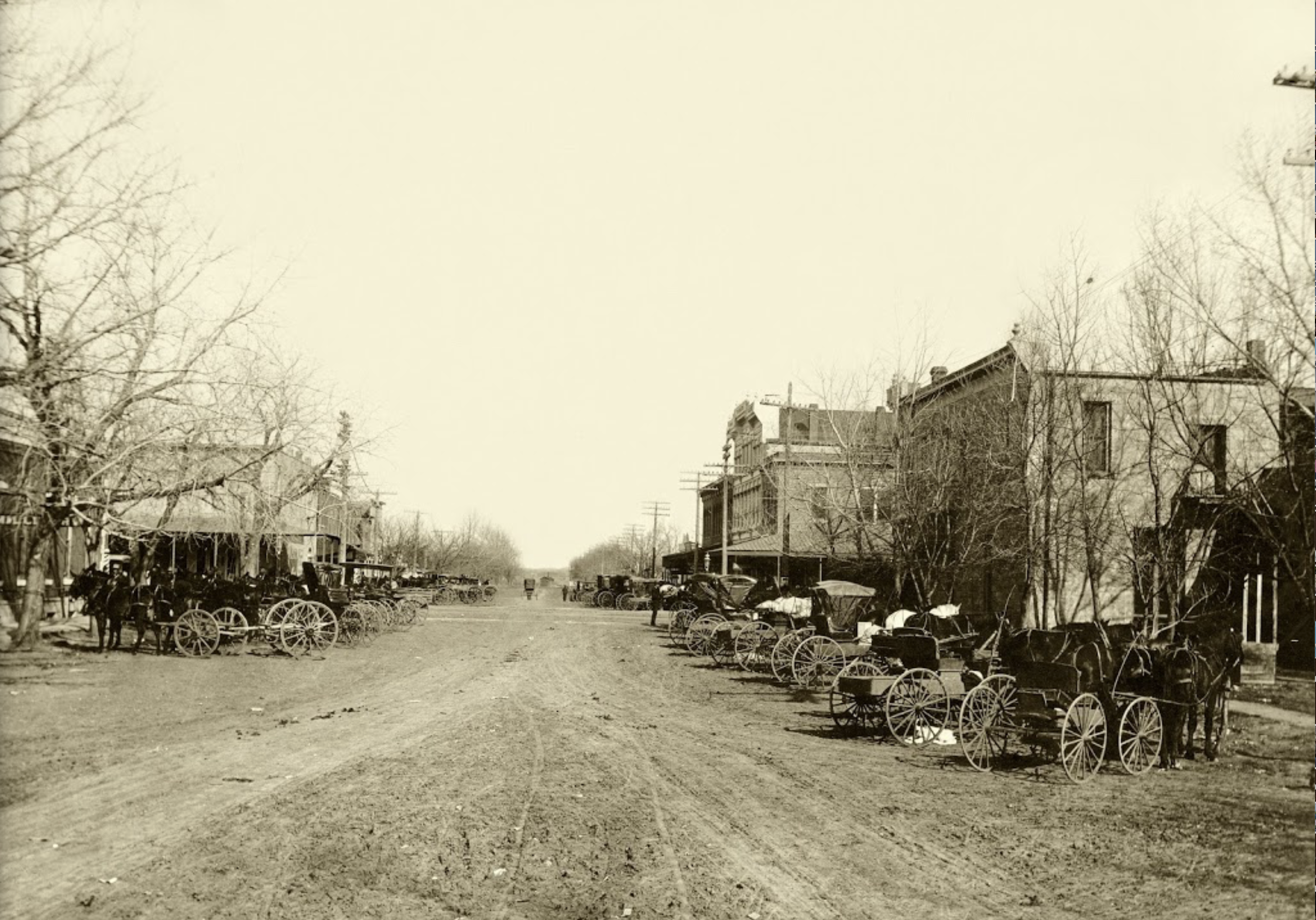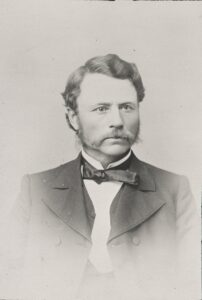By Joe Stumpe
The Butler County War – an explosion of vigilante violence and intimidation unique in Kansas history – actually started in Sedgwick County. And its immediate cause was a mule.
One day in November 1870, a 22-year-old named James Crawford rode the animal in question into Wichita. Four armed men relieved him of the beast, claiming it was stolen. Crawford and his family managed to get the mule back, but a few days later, they awoke to find five more animals stolen from their claim south of town.
The Crawfords tracked the men they believed responsible to Douglass, in Butler County. It was election day, Nov. 8, and the tiny town was bustling. The Crawfords didn’t approach the alleged thieves, but instead began asking questions about them.
Horse theft was a serious problem. It was the number one cause of lynching – that is, extrajudicial killing – in Kansas at the time. Butler County’s first newspaper, the Walnut Valley Times, regularly called for mob action against the thieves, editorializing in April 1870 that “Lynch law should be put in force.”
Whether it was that encouragement or the Crawfords’ persuasiveness, a mob gathered in Douglass that day. Around sundown, it started out for the home of a hog farmer named Lewis Booth, where it was believed the alleged thieves were staying.
About 9 p.m., the mob burst into Booth’s home on the Walnut River north of Douglass. As his wife watched, they walked Booth, his brother George and a third man, Jack Corbin, to a small grove of trees about 100 yards away. They hung Corbin from the branch of a sycamore. When the two Booth brothers made a run for it, they were shot dead.
Another one of the alleged thieves, James Smith, was also shot dead that night. His body was left on a creekbank south of Douglass.
Were the men actually horse thieves? It’s possible, but there is one big argument against it: In Corbin’s pocket was found an order from the government authorizing him to retrieve stolen government property, such as U.S. Army mules, and return it to the proper authorities. In fact, Corbin was a rather well-known figure because of his military exploits.
And what about the vigilantes? They were a cross section of settlers. Some had been in the area a few years, many had arrived only that same year. Many were farmers of modest means, although they would soon receive support from some of the area’s most prominent citizens.
Newspaper coverage of the four killings was generally supportive of the vigilantes. On Dec. 16, the Walnut Valley Times reported that new settlers would find “peace and prosperity” in Butler County because of the dispatching of the thieves.
The vigilantes claimed they acted because local law officers would or could not enforce the law. But in his reaction to the hangings, Sheriff James Thomas showed that he took his job seriously. Warrants were sworn out against 87 men and one woman accusing them of murder or complicity in the killings. Thomas tried to arrest the accused, but most refused to be taken into custody.
A group of Douglass men tried to help the sheriff. Their leader was William Quimby, who had moved to the area that same year and opened a general store. The others included a local physician, Dr. James Morris; his son, Alexander, who ran the family’s drugstore; and Michael Drea, a young Irish immigrant who clerked in Quimby’s store.
Why the four men became involved isn’t known. Quimby previously served as sheriff of Lyon County, Kansas – then known as Madison County – and may have known two of the men who’d been killed. He was 35 years old, married with five children and had established himself as perhaps Douglass’ biggest civic booster during his short time there.
As for Dr. Morris, he had treated one of the vigilantes who’d been injured during the killing of the four men on Nov. 8. Some of the vigilantes tried to negotiate a solution to the standoff with Quimby and Dr. Morris, but nothing came of it.
By late November, a few arrests had been made in the killings. In El Dorado, four vigilantes were scheduled for trial on Nov. 29.
In the meantime, the vigilantes accused Quimby and his group of being part of the horse theft ring. They were arrested on Nov. 28. A judge ordered them held under guard at Quimby’s general store in Douglass.
The timing was critical. With the witnesses against them locked up and unable to testify, the vigilantes in El Dorado were acquitted and set free.
But the vigilantes weren’t taking any chances.
On Dec. 2, a mob of between 70 and 100 men came to Quimby’s store in Douglass. Quimby’s wife, Martha, reportedly pushed her way through the vigilantes and handed her husband a revolver. “Take it and shoot your way out, or die like a man,” she told him. “Otherwise they will kill you as they would a dog.” Quimby declined.
The vigilantes marched the
four men through snow to a site about 1½ miles south of Douglass. They hung them from ropes tied to the plank set between two trees. The bodies were left dangling until the next day, with frost collecting on their bodies adding to the ghastly sight.
Butler County authorities turned to the state for help.
Sheriff Thomas went to Topeka the next day to ask Gov. James W. Harvey for help. The vigilante force was estimated at 180 men. At least two companies of cavalry would be needed to suppress them.
Gov. Harvey ordered the state’s highest-ranking military official, Adjutant General David Whittaker, to El Dorado with soldiers and a shipment of arms. Whittaker arrived Dec. 7. The next day, he met with a group of what he described as “law abiding citizens of Butler County.” The group said they wanted the law enforced but did not want the vigilantes arrested until the excitement died down.
Meanwhile, local residents on both sides of the fight mobilized. The vigilantes formed two battalions of men to guard the main road north of Douglass. Another advanced up the road toward Augusta, where friends of the second set of hanged men had gathered.
James R. Mead, the state senator for Butler County, threw his support behind the vigilantes. On Dec. 8, Mead wrote the governor, denigrating the character of most of the men who’d been killed. James Smith never did anything but “steal, gamble and murder since he was a boy,” Mead said. Jack Corbin was a “government mule thief.” George Booth sold whisky to the Indians and used the proceeds to set up a hideaway for horse thieves. Quimby was a “professional gambler” and “captain” of the gang of horse thieves. Mead didn’t say anything about the remaining three victims – Dr. James Morris, his son Alexander or Michael Drea.
Whittaker returned to Topeka without incident on Dec. 10. The vigilantes’ attorney, William Hackney, later claimed that he personally negotiated an end to the confrontation. The vigilantes agreed to be arrested, but only if they were released on their own recognizance. Over the next few weeks, charges against all but three of the vigilantes were dropped.
Politics may also have played a role in the drama. Kansas was then controlled by the Republican Party. Quimby was a prominent Democrat. The location of the county seat in Butler County was in contention in those days, and there was also a move to carve a third county out of the southern part of Butler County and the northern part of Cowley County. Was Quimby on the wrong side of some of his new neighbors for reasons beyond his desire for justice?
Of course, a simpler explanation is that the vigilantes were eliminating their opponents.
The vigilantes now set out to discourage any more attempts at justice.
In January, a month after the second set of killings, the vigilantes published a “manifesto” in the Cowley County Censor that claimed to be “printed by the order of Seven Hundred and Ninety eight organized men, comprising the Vigilantes of Butler, Cowley and Sedgwick counties.” According to the vigilantes, the second group of victims were killed because they threatened the vigilantes. The manifesto claimed that Quimby and the Morrises had confessed before their executions, giving the names of over one hundred members of the horse theft gang allegedly operating in the region. It was now known that “Sheriffs, Constables (and a) Justice of the Peace” belonged to the gang. If local authorities continued to try to prosecute the vigilantes, the manifesto warned, “blood will run like water.”
The three vigilantes still facing charges were represented by Hackney and his law firm. But there was to be no trial. Hackney was on his way to the log cabin courthouse in El Dorado when a leader of the vigilantes told him his services would not be needed. This vigilante leader then told the judge and prosecutor in the case: “This is to notify you that these men will not be tried, and if necessary to kill some officials to prevent that, their blood will be upon their own hands, not ours.”
“Pale as death,” according to one account, the prosecuting attorney said too much blood had already been shed and seeing how a conviction was unlikely, the charges should be dismissed. The judge agreed.
As in most wars, the victors wrote the history. After the violence subsided, the Walnut Valley Times and other area newspapers reported that new settlers had nothing to fear from criminals, even as the same newspapers printed notices of horses continuing to be stolen. Some people left the county and hard feelings remained among some who stayed. Martha Quimby reportedly put a curse on those responsible for her husband’s death. On the 25th anniversary of the conflict, seven residents wrote letters to the Walnut Valley Times attesting to William Quimby’s innocence.
Note: This account relies heavily on Lisa Miles Bunkowski, who wrote “The Butler County Vigilantes: An Examination of Violence and Community, 1870” while pursuing a doctoral degree at the University of Kansas. “The Violent Years: The Founding of Douglass, Kansas,” a book by John Mark Alley, “History of Butler County Kansas” by P. Mooney and contemporary newspaper accounts were also consulted.










